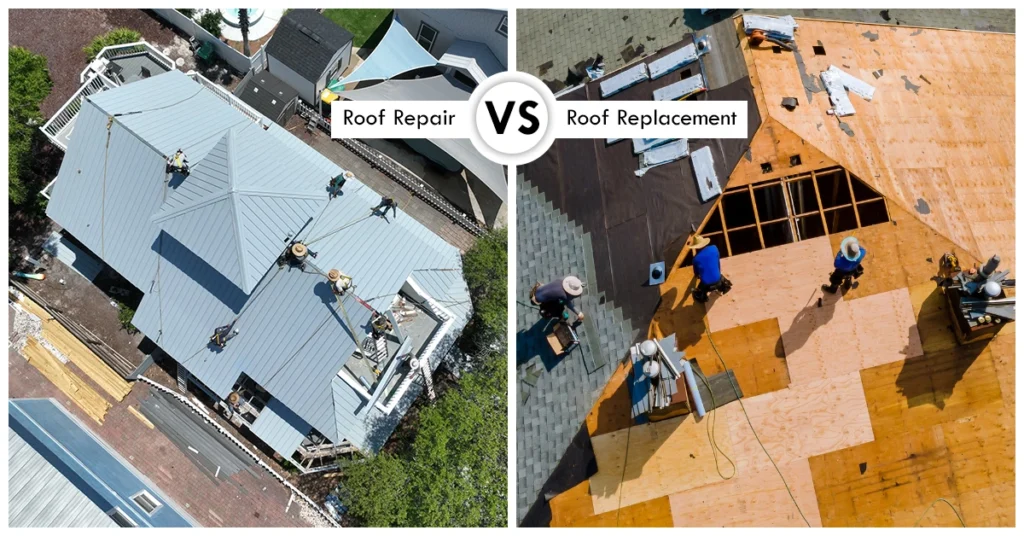Your roof protects your home. It keeps the rain out. It stops the sun from heating things up too much. It blocks wind and keeps your family safe. But over time, even the strongest roof starts to wear down. At some point, you’ll have to make a choice. Should you fix the roof or replace it completely?
This guide will walk you through both options. It will help you spot the signs of damage and understand which path makes more sense for your home. Whether you go for a roof repair or a full roof replacement, it’s better to decide early than to wait too long.
What Happens to a Roof Over Time
Roofs don’t last forever. They deal with various weather, like heat, rain, and hurricanes. They also handle leaves, branches, and even birds. Over time, all of this wears down the materials. Shingle roof can crack or go missing. Water can find its way into small gaps. If your roof is old, these problems can add up.
Most roofs last around 20 to 30 years. Some last longer if they are made of metal or tile. But once your roof is near the end of its life, it’s smart to pay closer attention. Small repairs might not help much if the whole thing is wearing out.
How to Know When a Roof Needs Help
You don’t have to climb up on the roof to know something is wrong. Start by looking for signs on the ground. If you see shingles that look loose, curled, or missing, that’s a clue. If there are dark patches or parts that look different from the rest, your roof might be holding moisture. Inside your home, watch for stains on the ceiling or walls. These usually mean water is getting in.
You might also notice higher energy bills. A weak roof can cause air leaks, but attics are supposed to vent. If your roof is making your home less efficient, it might be time for a change.
When a Repair Can Work
Not every problem needs a big fix. Sometimes, a simple repair can do the job. If only a few shingles are damaged, a roofer can replace them. If there’s a small leak around a vent or chimney, sealing that area might stop the leak. These kinds of repairs are quick and don’t cost much.
Repairs make sense when the rest of the roof is still in good shape. If your roof is under 15 years old and has only one or two small issues, a repair is a smart choice. It lets you fix the problem without spending too much money or time, and it also adds a few more years to the life of your roof.
Why Some Roofs Need to Be Replaced
Sometimes, fixing small parts won’t help. If the damage is spread across a large area, or if you have leaks in more than one spot, repairs won’t last. If the roof is sagging, that’s a sign of deeper problems. It could mean water damage or a weak structure underneath.
If your roof has already needed several repairs, it may be better to stop patching and start fresh. Roof replacement may seem like a big step, but it gives you a clean slate. A new roof protects better, saves energy, and adds value to your home.
What Happens During Roof Replacement
Roof replacement means taking off all the old roofing material and putting on new material from scratch. It takes longer than a repair, but the results last much longer. You can also choose better materials this time. New shingles, better underlayment, and improved ventilation can make your home safer and more comfortable.
During replacement, roofers will check the wood under your old roof. If any parts are soft or rotted, they will replace them, too. Then, they’ll install the new layers one by one. Once the work is done, you’ll have a brand new surface that will last for many years.
Choosing the Right Material
When it’s time to replace a roof, you get to pick new materials. Asphalt shingles are the most common. They’re affordable and work well in many places. Metal roofs last longer and handle heat and hurricanes better. Tile or clay roofs are strong and beautiful, but they weigh more. Each type of roof has pros and cons.
Think about your area’s weather, your home’s style, and your budget. Ask a roofer which type works best for you. No matter what you pick, make sure it’s installed properly. A well-installed roof will perform better and last longer.
What About Roof Replacement Cost
Many people worry about the cost of roof replacement. It’s true that a new roof costs more than a small repair. But the price depends on a few things. The size of your roof, the materials you choose, the shape of your roof, and the work needed to remove the old roof all play a part.
There is no one answer that fits every home. That’s why it’s best to ask for a quote from a local roofer. They can look at your home and give you a complete plan with the cost. This helps you avoid surprises and plan better. Think of it as an investment in your home’s future.
Repair vs Replacement: How to Decide
Still not sure which choice is right? Here’s a simple way to think about it.
- If the problem is small and your roof is still young, go with a repair.
- If your roof is old and the damage is everywhere, go for a roof replacement.
Also, consider how long you plan to stay in the home. If you’re planning to move soon, a repair might hold things over. But if this is your forever home, a new roof will give you peace of mind for many years.
Mistakes to Avoid
Some homeowners wait too long. They see a stain or a missing shingle and think it’s no big deal. But roof problems grow fast. Water gets in and spreads, rotting the wood, ruining insulation, and damaging walls.
Other people try to fix things themselves. That’s risky. Climbing on a roof is dangerous. You can make things worse if you don’t know what you’re doing. Always call a roofer if you’re unsure.
Some people also pick the cheapest option without asking questions. That can lead to poor work or cheap materials. Get a few quotes. Ask what’s included. Choose someone who explains things clearly.
What You Can Do Now
Walk outside and take a look at your roof. Check for signs of damage. Ask yourself how old your roof is. Think about how often you’ve had to call for repairs. These clues will help you decide what to do next.
If you spot issues, call a roofing expert. Professionals like Coastal Roofing Professionals can help guide you without pressure. They’ll assess your roof and suggest the best course of action.
FAQs
How do I know if my roof needs to be replaced or repaired?
If the damage is in one spot and your roof is fairly new, a repair may be enough. If problems keep showing up or the roof is old, replacement is usually the smarter choice.
How long does a roof usually last?
Asphalt shingles last about 20 years, while other materials like metal, tile, or slate can last much longer if properly installed and maintained.
Can I replace only part of my roof?
You can replace a section if the rest is still solid. However, mismatched materials can stand out; old parts may cause issues later.
How much does a roof replacement cost?
It depends on the size, shape, and material of your roof. Get a quote from a local roofer so you know what it would cost for your home.
Will a new roof help lower my energy bills?
Yes, newer roofs often reflect heat better and keep homes cooler, which can help the heating and cooling system use less energy.
How long does it take to replace a roof?
Most homes take one to three days, depending on size and weather. Big roofs or special materials can take a bit longer.
Conclusion
Your roof is one of the most important parts of your home. It keeps everything underneath it safe and dry. When something goes wrong, don’t wait too long to act. A small repair might be all you need. But if your roof is worn out or breaking down in many places, roof replacement is a better choice.
Take the time to check your roof today. Ask questions. Talk to a pro. Make the smart choice before a small issue turns into a big problem. Your home will thank you for it.


